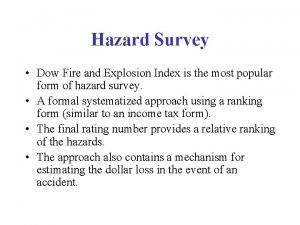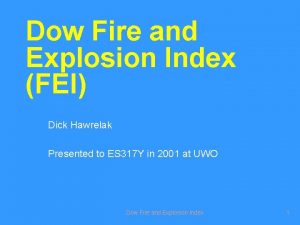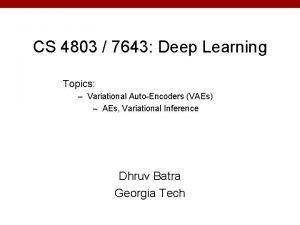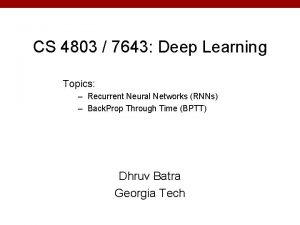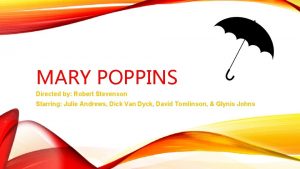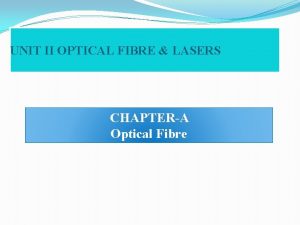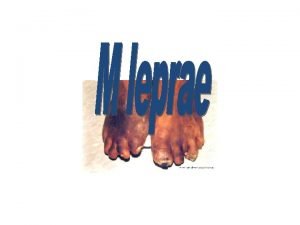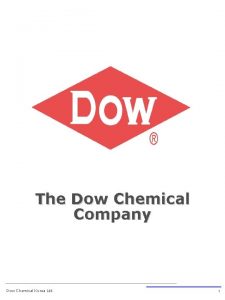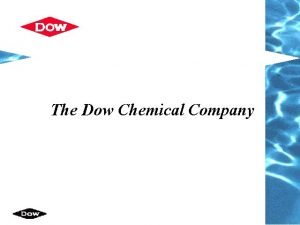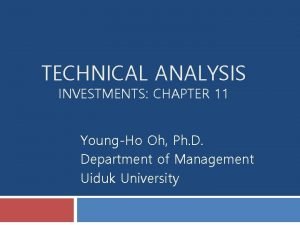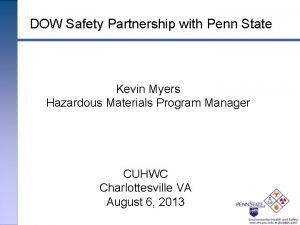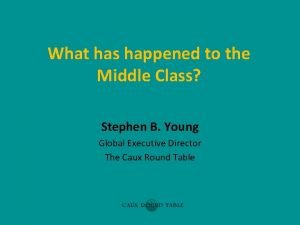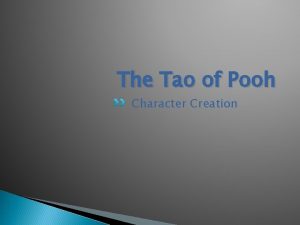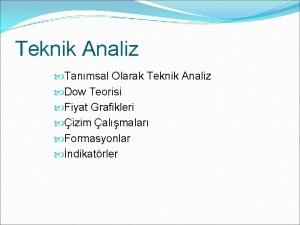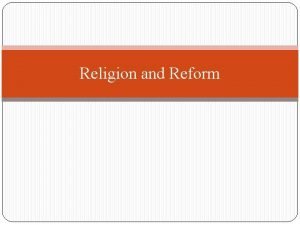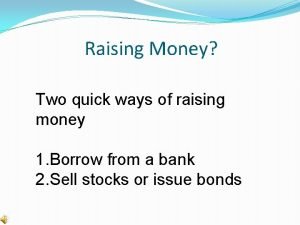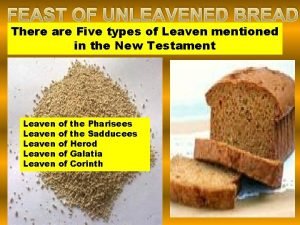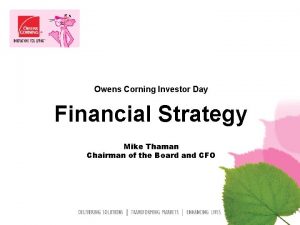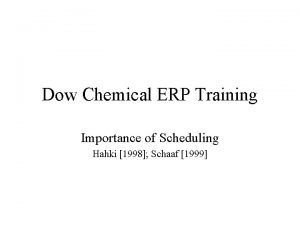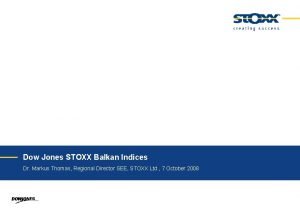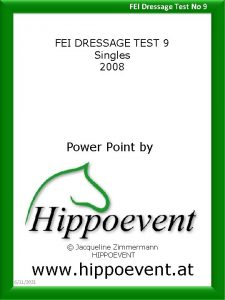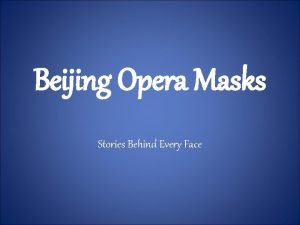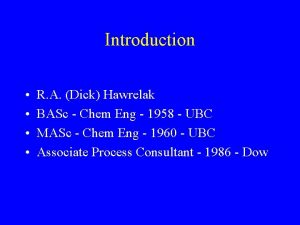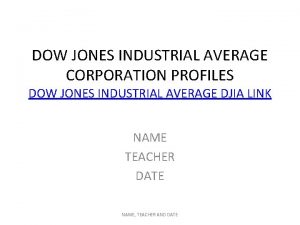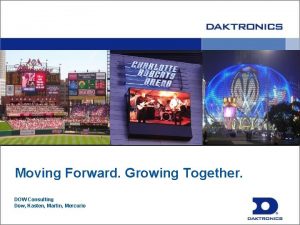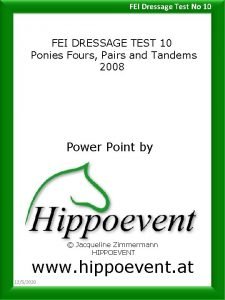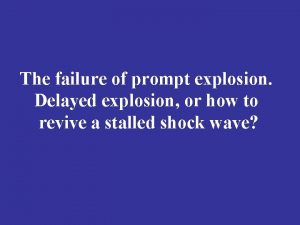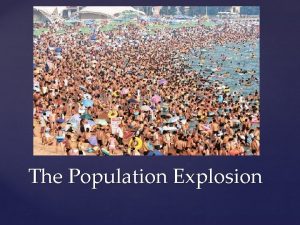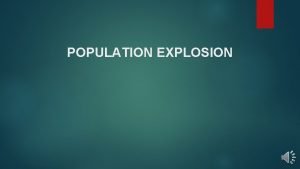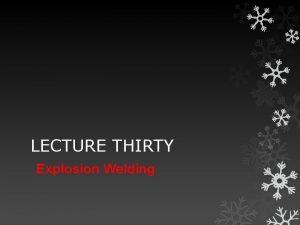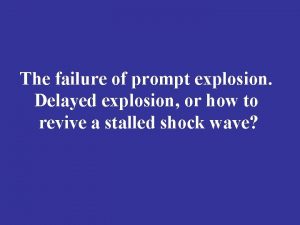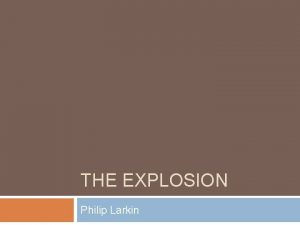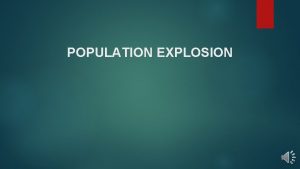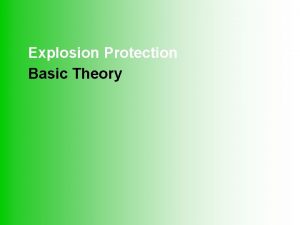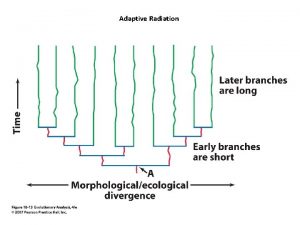Dow Fire and Explosion Index FEI Dick Hawrelak





























- Slides: 29

Dow Fire and Explosion Index (FEI) Dick Hawrelak Presented to ES 317 Y in 2001 at UWO Dow Fire and Explosion Index 1

Introduction n n V 1. 0 was first Issued in 1964 By Bill Braise (RIP). V 7. 0 was last issued in 1994 and is now marketed by the AICh. E ($50/copy). FEI is widely used outside of Dow. FEI is the leading hazard index methodology recognized by the chemical industry. V 7. 0 is available on my CD in Folder (9) as Dow FEI V 1. 3. Dow Fire and Explosion Index

What is the Dow FEI? n The Dow FEI is a ranking system that gives a relative index to the risk of individual process units due to potential fires and explosions. Dow Fire and Explosion Index

What is the Primary Purpose of the Dow FEI? n n It serves as a guide for the selection of fire and explosion protection methods. It assists in determining the spacing between adjacent process units within the ISBL. It is a guide for insurance agencies to set insurance rates. It ranks individual process units where special safety attention can be focused. Dow Fire and Explosion Index

When should one perform an FEI? n Late in Phase III Engineering after: P&IDs have been completed, u Equipment has been sized, u A trial equipment layout has been done, u A DFC estimate has been completed. u Dow Fire and Explosion Index

Who Usually Performs the FEI? n n Generally a senior process engineer, who is acquainted with the details of the project, is assigned the task. Occasionally, different groups tackle the assignment and results are compared for consensus building. Dow Fire and Explosion Index

What Does the FEI Consider? n n n Six general process hazards. Twelve special process hazards. Nine process control credit factors. Four material isolation credit factors. Nine fire protection credit factors. Dow Fire and Explosion Index

General Process Hazards n n n Exothermic reactions. Endothermic processes. Material handling and transfer Enclosed or indoor process units. Access. Drainage and spill control. Dow Fire and Explosion Index

Special Process Hazards n n n Toxic materials. Sub-atmospheric pressure (<500 mm. Hg). Operating in or near flammable range. u Tank farm storage flammable liquids. u Process upset or purge failure. u Always in flammable range. n n Dust explosion. Pressure. Dow Fire and Explosion Index

Special Hazards Cont’d n n Low temperature. Quantity of flammable/unstable material. u Liquids or gases in process. u Liquids or gases in storage. u Combustible solids in storage. n Corrosion and erosion. Dow Fire and Explosion Index

Special Hazards Cont’d n n Leakage – joints and packing. Use of fired equipment. Hot oil heat exchanger system. Rotating equipment. Dow Fire and Explosion Index

Process Control Credit Factors n n n Emergency power. Cooling. Explosion control. Emergency shutdown. Computer control. Dow Fire and Explosion Index

Process Control Factors Cont’d n n Inert gas. Operating instruction procedures. Reactive chemical review. Process hazard analysis. Dow Fire and Explosion Index

Material isolation Credit Factors n n Remote control valves. Dump or blow down control. Drainage. Interlocks. Dow Fire and Explosion Index

Fire Protection Credit Factors n n n n n Leak detection. Structural steel. Fire water supply. Special systems. Sprinkler systems. Water curtains. Foam. Hand extinguishers. Cable protection. Dow Fire and Explosion Index

FEI Example Dow Fire and Explosion Index

General Process Hazards Dow Fire and Explosion Index

Special Process Hazards Dow Fire and Explosion Index

Fig 8: Damage Factor Dow Fire and Explosion Index

Process Control Credit Factors Dow Fire and Explosion Index

Material Isolation Factors Dow Fire and Explosion Index

Fire Protection Credit Factors Dow Fire and Explosion Index

Credit Factor Summary n n Process Control, C 1 =0. 75 Material isolation, C 2 = 0. 88 Fire Protection, C 3 = 0. 79 C 1 x. C 2 x. C 3 = (0. 75)(0. 88)(0. 79) = 0. 52 Dow Fire and Explosion Index

Process Unit Risk Analysis Summary Dow Fire and Explosion Index

Plot Plan Summary Dow Fire and Explosion Index

Features Not Used In V 7. 0 Dow Fire and Explosion Index

Limitations of Dow FEI n n No scientific basis for many of the features can be found in Dow records. Fig 8 is an example. (RAH study – 1993). Does not correlate well with known plant disasters (Flixborough, Phillips, Norco). While explosion damage is fairly advanced (Flixborough – 1974), fire damage alone is more difficult to predict. Not scenario driven as in recent QRA work in Holland the U. K. Dow Fire and Explosion Index

Recent Trends n n n Insurance companies are looking at Maximum Foreseeable Loss, (MFL), based on Baker‘s- 1994 blast technology for Detonations and Deflagrations as applied to plant equipment layout. There is a trend toward higher insurance premiums as insurance companies adjust their actuarial data. Many chemical companies may follow Exxon’s trend to insure themselves. Dow Fire and Explosion Index

End Of Show n Your Department should have a copy of the 7 th Edition available for further examination and application to your projects. Dow Fire and Explosion Index
 Fire and explosion index
Fire and explosion index Explosion w fei
Explosion w fei Fei fei li
Fei fei li Fei fei li
Fei fei li Julie anderson mary poppins
Julie anderson mary poppins Diff between step index and graded index fiber
Diff between step index and graded index fiber Bacteriological index vs morphological index
Bacteriological index vs morphological index Pqli advantages and disadvantages
Pqli advantages and disadvantages Waveguide in optical fiber
Waveguide in optical fiber Liquid limit of soil formula
Liquid limit of soil formula Dow chemical company profile
Dow chemical company profile Dow cationic pretreatment
Dow cationic pretreatment Dow theory principles
Dow theory principles Teoria de dow
Teoria de dow Dow safety training
Dow safety training Dow jones industrial average
Dow jones industrial average Tao of pooh which character are you
Tao of pooh which character are you 2 618 formasyonu
2 618 formasyonu Neal dow religion
Neal dow religion Dow jones industrials
Dow jones industrials Types of unleavened bread
Types of unleavened bread Owens corning investor relations
Owens corning investor relations Dow word
Dow word Dow chemical training program
Dow chemical training program Technical analysis in project management
Technical analysis in project management Balkan dow
Balkan dow Corning korea
Corning korea Lowk dow
Lowk dow Fei dressage tests
Fei dressage tests It symbolizes roughness and fierceness
It symbolizes roughness and fierceness
